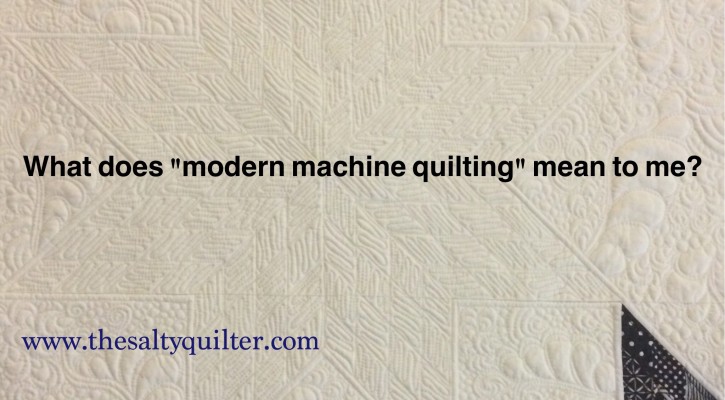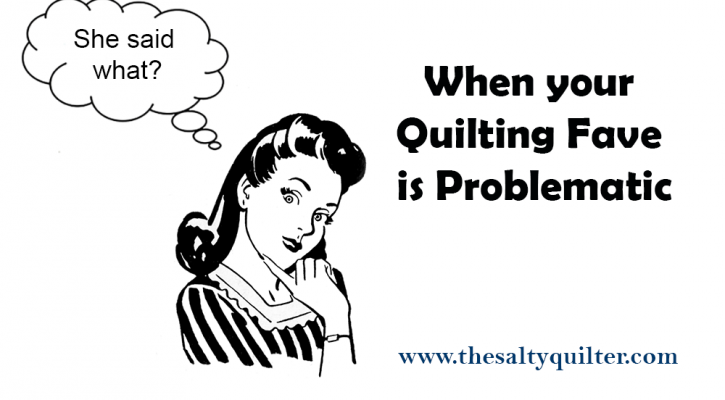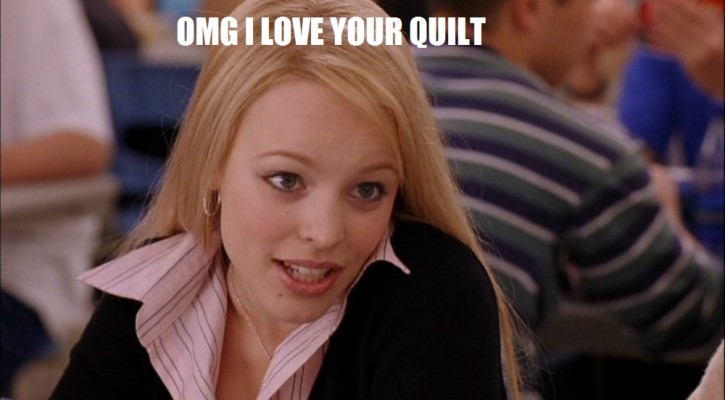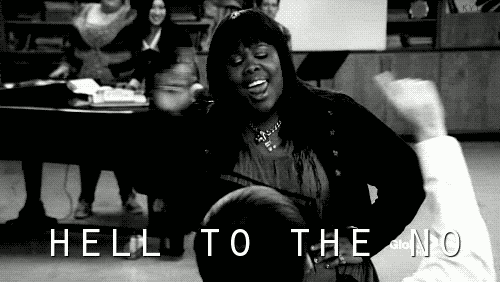Tag: Criticism

Modern Machine Quilting – What does it mean to me?
January 14, 2016
Hello and Happy New Year! I’ve had quite the month healthwise (on the mend) and unfortunately my blog has been neglected.
But, I had a prompt today I couldn’t refuse. Forgive me for a slightly more freeform blog post. 😉
The lovely Christa Watson of Christa Quilts asked a question in the Facebook Group Modern Quilting…Exploring A Fresh Horizon (you should join if you aren’t a member already). She asked:
What does “modern machine quilting” mean to you?
Hoo boy, Christa you may regret asking me that question. I will preface this by saying that free motion quilting is probably my favourite part of the quilting process. And I’ve worked hard to become proficient and skilled in this area. So I am certainly biased.
I will say that “modern machine quilting” is NOT limited to straight line or matchstick quilting. I saw a lot of this style of quilting on the quilts displayed at QuiltCon. I even took a class about it with Jacquie Gering, the patron saint of matchstick quilting, at QuiltCon.
I hate to say it, but straight line quilting, to me, is basically the “all-over meander” of the modern quilting world. It’s effectively a quilt Zamboni, mowing down the texture of the quilt.
Now, that’s not to say that this type of quilting shouldn’t be used. It certainly suits many “modern” styles. But there are so many other options out there.
With all that wonderful negative space that modern quilts often provide, why not fill it with fabulous free motion quilting!?! We’ve seen some fantastic examples of skilled quilters using and enhancing negative space. Angela Walter‘s quilts immediately spring to mind.
What about using a traditional pattern in a new and modern way? How about Angela Walter’s Creepy Feathers on a Tula Pink quilt? How about the extra layer of meaning added to Thomas Knauer’s Pride quilt by quilting a double wedding ring pattern over the rainbow piecing (pretty sure Lisa Sipes did the quilting)?
I’m reminded again of the five stages of grief I went through watching Jacquie Gering’s What is a Modern Quilt webinar in 2014 – one of my major sticking points was that the quilting should be secondary to the design.
To this I say:
Quilting gives us another way to express our creativity. Take advantage of the opportunity to make your quilt truly spectacular.
As OG Quilter Harriet Hargrave says:
The quilting makes the quilt.
Yes, it should enhance the piecing/quilt top – that’s the goal for the quilting on EVERY quilt, whether traditional, contemporary, art or modern in style.
But in no way, shape or form, should quilting be considered the red headed stepchild of the modern quilt world.
¡Viva la modern machine quilting revolution!

“Liberty Leading the People,” a depiction of the French Revolution. Painting by Eugène Delacroix, 1830. Public domain.
Anyway, that’s my rant for now. I should probably go back and add in some pictures at some point, but I’ve at least gotten it off my chest.
I’ll be keen to check out Christa’s webinar for MQG members.
What do you think? What does “modern machine quilting” mean to you? Let me know in the comments, or hit up the original FB post.

When Your Quilting Fave is Problematic
August 31, 2015
More and more in recent years, the bad behaviour of those we admire seems to be popping up to the surface. Particularly when it comes to celebrities and social media, an offensive comment is literally one tweet away. So how do we deal when these kinds of behaviours or comments come from a favourite quilter, shop, group, or quilt celebrity?
50 Shades of Nope
When it comes to behaving badly, we have to admit that there is a spectrum – shades of gray, and those can vary from individual to individual. It’s up to you to decide what crosses your line, and what doesn’t.
I had an instance recently where a well known local professional quilter made comments disparaging of legalising gay marriage on her Facebook page. There was also an implied invocation of “freedom of speech” and “it’s my page, I’ll say what I want.” Was this comment as bad as using a homophobic slur? Of course not. However, on my personal scale of grayness, it’s still in the territory where I am not keen on purchasing this person’s services. And that’s my freedom of choice as well.
Many people will remember the stoush last year when Abby Glassenberg of While She Naps called out Aurifil Thread’s spokesman Alex Veronelli for making repeated sexist comments and behaviors on social media. I had actually unfollowed Veronelli on Twitter earlier that year for making a bad joke about women drivers, so I was definitely in agreement with Abby, along with many other quilters. I think it was extremely brave for Abby to do this, since the quilting community generally has a no-criticism allowed policy. However, there was definitely a vocal group of women quilters who defended Veronelli unequivocally and unreservedly. Veronelli did end up “apologising”, but it was personally very disappointing to see women who I admired wallowing in internalised sexism. Unfortunately this is not uncommon in the quilting arena.
Time Heals all Wounds
Did these comments or actions occur long ago? Perhaps when the individual was less aware/open minded? Have they apologised sincerely (see below) and made effort not to re-offend? If so, and depending on the shade of gray, I think it’s worth recognising that this may be an embarrassing episode that won’t happen again. Second chances are more than fair. Third and fourth chances though… pushing it.
Was there a sincere apology?
Along with the rise of public offensive behavior, the non-apology has followed closely behind. “Sorry to those who were offended” is not a sincere apology. A sincere apology recognises the hurt, takes personal responsibility, and offers ways to make amends. If a sincere apology hasn’t been made, does that person deserve forgiveness? Let’s just say, I still don’t buy Aurifil thread.
Separate the Art from the Artist
As with broader pop culture, sometimes we must try to separate the art from the artist. There’s something amazingly human in the way people can parse appreciating someone’s talent and execution, while still condemning their actions. To a point.
Traditional Quilts, Traditional Values?
For many younger and international quilters, I think it’s hard to understand just how conservative the traditional American quilt culture is.
The Quilting in America 2014 survey (PDF) shows that quilter demographics skew female, older, richer, and traditional in style. The survey doesn’t mention race, but I have no doubt white quilters make up the majority of the overall demographic. Part of this could be as a result of the measurement techniques (demographics were listed for “Dedicated Quilters” who spent “more than $500 a year on quilting-related purchases”, obviously this will mean more well-off individuals), but I think it does reflect the general make-up of active and vocal quilt consumers in the USA, and likely other Western nations.
Something that is slightly more unique to the USA is the deeply conservative, traditional and religious demographic that comes with quilting. Unless you grew up in it it’s hard to comprehend just how pervasive, and sometimes indistinguishable, religion can be as part of the culture in the USA. And this inevitably filters down to specific groups. And quilting itself is often tied to specific religious groups, such as the Amish. When I first started quilting in my twenties in Las Vegas, I had friends ask me if I was Mormon, just because I quilted.
I was a member of a very large (20k+) USA based Facebook quilting group for several years. I eventually had to leave the group due to a constant overtone of sexism, jingoism and religious privilege.
While it’s important to realise that quilting comes from a highly traditional background, and that can reflect in the actions and comments of those who participate, it’s also essential for those members who are more progressive to speak out, even when it can be difficult and controversial.
In conclusion…
Each quilter must decide the where on her personal spectrum a behavior or comment falls. What crosses the line for me, may not for others and vice versa. In the end, you have to put your money where you mouth is.
How have you dealt with a problematic fave? Do you think people should be more vocal in addressing what they see as issues? I’d love to know your thoughts.

Are Quilters Too Nice?
August 5, 2015
Over and over again, I’ve heard or read about the “kindness of quilters” from other quilters. While quilters are certainly kind as a group, often going out of our way to help out or support other quilters, are we too nice?
I’m talking about the sometimes saccharine sweet reaction when you show off a new quilt. “It’s lovely!” “Wonderful.” “Well done.” et al, repeat as necessary.
As great as it is to hear that about your quilt, does it really help you to improve as a quilter?
Honest and helpful constructive feedback
Many of us quilt in a vacuum. We sew alone. The quilt may be seen by a family member or the person who is receiving it, but they often don’t know enough to be able to give informed feedback.
Those of us who belong to a quilt guild may have the opportunity to show our quilts to other quilters, but I’ve found that unless you ask for specific feedback, people are reluctant to give critical feedback (and for good reason! It’s a minefield.)
Ask for feedback
I’ve found that asking for honest, helpful feedback can really boost my quiltmaking. Often it re-enforces something that I’ve noticed myself. It gives me something to stride for when making my next quilt. Never underestimate the power of lessons learned.
It can be difficult to communicate what I’m looking for; often I find asking other people how they would do something is a good method. “What kind of border would you put on this quilt?” “How would you quilt this?”
Or asking for feedback on an idea. “I’m thinking about doing orange and blue, what do you think?”
For after a quilt is completed, ask what someone might do differently, or if they think a certain component works. If there was a problem or issue with the quilt, I ask about how they would overcome it if they had the problem.
And don’t forget – there is no obligation to take or use the feedback received. Consider it and move on.
Entering and attending quilt shows
Quilt shows are an excellent opportunity to get a critical review of your quilt. Some quilt shows (not all) will give you feedback from the judges. All the feedback I’ve ever received has always been honest and helpful, and gave me places to be sure I improved in the future.
One thing I’ve found over the years is that I love going to quilt shows with a partner. They can be quilters themselves, or at least interested in quilting. I like to discuss what I see with my partner. I’ll take a look at a quilt and try to figure out what I like or dislike about it. Is it subjective or objective? If it’s not my style or preference, is there something the quilt maker has done well? Is there something that could be improved upon technically? Would I have done something different?
I try to imagine that if the quilter overheard me discussing her quilt, she would feel that I’m trying to make an honest assessment. Just talking about it helps me to remember to apply what I’ve learned and what I’ve seen to my own quilts.
Pick your moment
Now obviously, in many public places (virtual or real life) it’s best if you have nothing nice to say to not say anything at all.
I’ll never forget when my Star of India quilt was on display at the Royal Canberra Show (like a state fair, for my fellow Americans). I won first prize for contemporary quilts, which was a wonderful surprise. I put a lot of work into this quilt and was pretty darn chuffed. When I got to the show to see it, I took a picture to post on social media and was hanging around, when a woman with a pram and her friend approached. The woman pointed at my quilt and said “Oh my god, it’s awful! I can’t believe that won.” I will admit I did a bit of a double take. Now, I typically will not hesitate to jump in and stand up for myself, but homegirl looked like she would throw down, so I demurred. But I’ll never forget it. (For the record, I am aware that my quilt is incredible and I’m proud of the job I’ve done.)
A large public Facebook group is probably not the place to start making unrequested feedback either. It’s amazing how quickly that can turn into a total shitshow.
There are a multitude of articles on Google for how to give constructive feedback, and it’s worth taking a look before wading in.
You can be constructive without being a Mean Girl.
In conclusion…
In the right place, at the right time, with the right people requesting honest constructive feedback, it’s probably more helpful to offer suggestions than just to say “Wow!”


